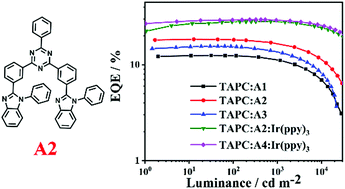Benzimidazole–triazine based exciplex films as emitters and hosts to construct highly efficient OLEDs with a small efficiency roll-off†
Abstract
Although efficient exciplex-based organic light-emitting diodes (OLEDs) with simple device structures have shown great progress recently, highly efficient electron acceptor materials are still rare. Here, a series of newly developed electron acceptors for exciplex-OLEDs composed of benzimidazole and triazine hybrids are discussed. All three compounds display a triplet energy of 2.67–2.69 eV, ensuring a high photoluminescence quantum yield of 78.0–89.7% when mixed with an electron donor (TAPC: 4,4′-cyclohexylidenebis[N,N-bis(p-tolyl)aniline]). Exciplex-based OLEDs with these electron acceptors and TAPC blend films as the emitting layers exhibit low driving voltages of 2.6–3.0 V at 100 cd m−2 and 3.1–4.2 V at 1000 cd m−2. High efficiencies of 53.2–80.1 lm W−1 and 39.7–60.1 cd A−1 are obtained, and the highest external quantum efficiencies (EQE) are 12.5–18.4%. Green electro-phosphorescent emitters are also fabricated with exciplex-based cohosts by doping with tris(2-phenylpyridine)iridium (Ir(ppy)3), one of which shows the highest EQE of 29.6%, and the EQE can be maintained at 27.4% at 5000 cd m−2. Therefore, the benzimidazole–triazine electron acceptors show promise as exciplex emitters and cohosts for OLEDs.

- This article is part of the themed collection: Journal of Materials Chemistry C HOT Papers


 Please wait while we load your content...
Please wait while we load your content...